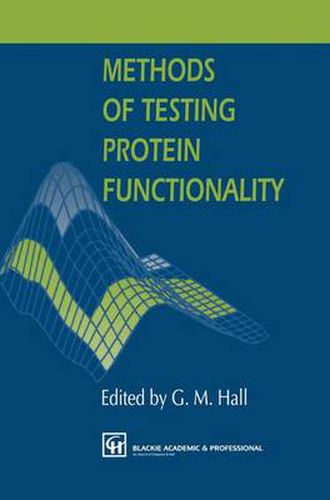Readings Newsletter
Become a Readings Member to make your shopping experience even easier.
Sign in or sign up for free!
You’re not far away from qualifying for FREE standard shipping within Australia
You’ve qualified for FREE standard shipping within Australia
The cart is loading…






This title is printed to order. This book may have been self-published. If so, we cannot guarantee the quality of the content. In the main most books will have gone through the editing process however some may not. We therefore suggest that you be aware of this before ordering this book. If in doubt check either the author or publisher’s details as we are unable to accept any returns unless they are faulty. Please contact us if you have any questions.
Protein functionality is big business in the food industry, both academic and commercial. This reflects the fascination of protein chemistry and the commercial value of proteins in giving texture and substance to foods. My first encounter with the subject came about through an interest in assessing the extent of thermal damage in spray-dried proteins. A change in functional properties seemed a useful guide to the thermal damage. I found the literature replete with methods (and theory) and so did what everybody else seemed to do - I devised my own methods which were slight variations on the general theme. However, being an analyst at heart I thought there must be a systematic approach to the various tests available. This book is an attempt to assess the practice of protein functionality testing, keeping theory to a minimum, followed by a suggested ‘standard’ method or protocol to follow. Each chapter is devoted to a single functional property and the reader will see that attempts to ‘standardise’ them have had varied success, perhaps reflecting the complexity of the mechanisms at work. As mentioned above theory has been kept to a minimum but hopefully it supports the practical methodology described. I hope that the book stimulates debate on the subject; it is certainly not the last word! G. H. Contributors Dr G. E. Arteaga Centro de Investigacion en Alimentation y Desarrollo, Hermosillo, Sonora AP 1735, Mexico Dr. S.
$9.00 standard shipping within Australia
FREE standard shipping within Australia for orders over $100.00
Express & International shipping calculated at checkout
This title is printed to order. This book may have been self-published. If so, we cannot guarantee the quality of the content. In the main most books will have gone through the editing process however some may not. We therefore suggest that you be aware of this before ordering this book. If in doubt check either the author or publisher’s details as we are unable to accept any returns unless they are faulty. Please contact us if you have any questions.
Protein functionality is big business in the food industry, both academic and commercial. This reflects the fascination of protein chemistry and the commercial value of proteins in giving texture and substance to foods. My first encounter with the subject came about through an interest in assessing the extent of thermal damage in spray-dried proteins. A change in functional properties seemed a useful guide to the thermal damage. I found the literature replete with methods (and theory) and so did what everybody else seemed to do - I devised my own methods which were slight variations on the general theme. However, being an analyst at heart I thought there must be a systematic approach to the various tests available. This book is an attempt to assess the practice of protein functionality testing, keeping theory to a minimum, followed by a suggested ‘standard’ method or protocol to follow. Each chapter is devoted to a single functional property and the reader will see that attempts to ‘standardise’ them have had varied success, perhaps reflecting the complexity of the mechanisms at work. As mentioned above theory has been kept to a minimum but hopefully it supports the practical methodology described. I hope that the book stimulates debate on the subject; it is certainly not the last word! G. H. Contributors Dr G. E. Arteaga Centro de Investigacion en Alimentation y Desarrollo, Hermosillo, Sonora AP 1735, Mexico Dr. S.